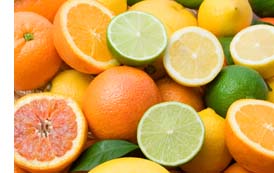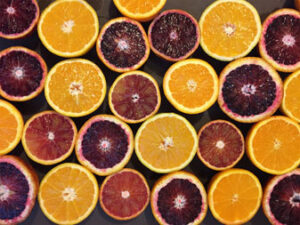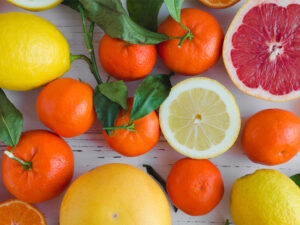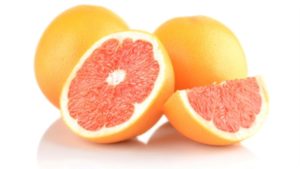Winter Citrus Guide
- By Pia Hinckle
- Reading Time: 8 mins.
Winter is the peak of the citrus season. Officially beginning on the winter solstice (December 21), the bright shades of orange, red, pink, yellow and green of citrus add brightness and light to the darkness of this time of year.

Nature gives us what we need when we need it most—eating winter citrus naturally boosts your mood with folate, your immune immune system with vitamin C, improves digestion with fiber, and satisfies sugar cravings. It is good for your heart, cardiovascular system, skin, and joints. While winter officially ends on the spring equinox on March 20, many types of winter citrus remain available into spring.
Citrus fruit comes from flowering trees and shrubs in the Rutacae family that produce citron, oranges, tangerines, lemons, limes, pomelos, grapefruit, kumquats, Buddha’s hand, yuzu, and other varieties.
Read more: What to do with Citrus
Why Eating Citrus is Good for You

Oranges are naturally high in folate (B9), a naturally-occuring B vitamin that is critical to maintaining optimal levels of serotonin. Low serotonin has been linked to depression and researchers have found that when your brain has low levels of folate, serotonin levels drop. This is because folate regulates the production of serotonin and dopamine, critical feel-good neurochemicals.
The high fiber content of citrus fruit also helps to lower cholesterol and improve digestion. It keeps us feeling full and satisfied longer than less-fibrous foods, making citrus a great snack for weight loss. Citrus also helps your body absorb iron, an important nutrient for the immune system and red blood cell production. The flavonoids contained in citrus have powerful antioxidant and anti-inflammatory properties that may help reduce the risk of developing a number of cancers, including breast, lung, and stomach cancers. The high vitamin C content in citrus (one orange has about 100 mg, about 130% of the recommended daily minimum) helps with collagen production, which leads to healthier skin and joints.
Video: Smile for Winter Citrus
Want Winter Citrus?
The FruitGuys Guide to Winter Fruit
Citrus is in full swing by mid-January with major growing regions such as California and Florida being the first to see a wide number of varieties. Fruit mixes in all regions will contain a large selection of citrus, locally-grown where it is available. While fruit mixes vary from region to region, here’s a guide to the types of fresh citrus that appear through the winter months.
regions will contain a large selection of citrus, locally-grown where it is available. While fruit mixes vary from region to region, here’s a guide to the types of fresh citrus that appear through the winter months.
Read More: How to Organize a Citrus Tasting for Your Staff
How to Use Citrus
Wash in cold water before peeling or slicing. Store on the counter away from heat and light for several days or in the refrigerator for up to two weeks. The peel has two parts: the brightly colored zest, which contains flavorful oils, and the spongy white pith beneath, which can be bitter. When a recipe calls for zest, remove the thin top layer carefully with a vegetable peeler or microplane so you can leave behind the pith.
Oranges

Navel oranges are the classic winter orange and a big favorite because of their extreme sweetness and easy-peel snackability. We love the heirloom navels from Bernard Ranches. Vince and Vicki Bernard bought their first citrus grove in Riverside, CA in the early ’80s and use all-natural growing and planting processes. They place flavor ahead of appearance and pick breeds that produce only the most delicious fruit. During the COVID-19 crisis, they told us how many oranges were at risk of going to waste because of closed farmers markets and restaurants and we sold 10-pound bags directly to consumers for them.
Cara Cara oranges are similar to navels but have bright coral-pink flesh that’s especially pretty. Blood oranges, popular in Europe, have stunning dark flesh that can range from magenta to deep burgundy, are sweet but muted by a raspberry-like flavor. Bergamot oranges are an old cultivar also known as a sour orange. Bergamot citrus is fragrant, orange-sized, and lime-colored. Extracts have been used for centuries in perfume and cosmetics, as well as Earl Grey tea. The flesh is quite sour but the peel is delightful to use in baking, cooking, or cocktails.
Mandarins, including tangerines, clementines, and satsumas, are cousins to the sweet orange. These varieties are smaller and more intensely flavored. Satsumas feel puffy and have a peel that opens like a zipper, making them a snack favorite. The Tangelo, a cross between the tangerine and the pomelo, has bright orange-red skin often marked by a protruding “button” on the stem end. They’re easily peeled into segments and boast a complex, honeyed sweetness. Pixie tangerines will make their appearance in March.
Grapefruit

Pink and red grapefruit contain the beneficial antioxidant lycopene. Even the extract from its seeds is a powerful antiseptic. However, be aware that grapefruit contains a compound that can interfere with the absorption of some statin-based medications. Check with your doctor or pharmacist if you use any drugs with statins. Drop us a note if you cannot eat grapefruit and want it held from your winter orders.
WARNING: Be aware that grapefruit, pomelo, and tangelo can interact with some drugs, including those for blood pressure, anxiety, cholesterol, and allergies. If you’re on medication, check with your healthcare provider or pharmacist before consuming these fruits.
Pomelo, or Pummelo, is the largest citrus fruit and ancestor to the grapefruit. This fruit is the pith! Seriously, huge deep white pith. Its taste is similar to a grapefruit but sweeter and less acidic.
Lemons & Limes
Lemons add bright acidity to cooking, vegetables, and salad dressings. Squeeze half a lemon into a glass of warm water in the morning to help alkalize your system and clear toxins from your liver. Meyer lemons are a sweeter, less acidic, variety that’s perfect for baking and squeezed fresh into water. Variegated Pink Lemons are a pink-fleshed Eureka lemon variety with flashy green and yellow stripes.
Limes have more acid and sugar than lemons. They are acidic enough to etch marble and other stone countertops so always use a cutting board when slicing limes. Lime juice and lime zest are key ingredients in South Indian, Mexican, Thai and Vietnamese cooking. Finger Limes contain juice vestibules likened to “lime caviar” and come in green and red varieties. Sweet Limes look and taste almost like a tiny orange, with very low acidity.
Kumquats & Mandarinquats
Kumquats are nature’s original sweet-tart! The skin is sweet and edible, as is the tart insides. The video below explains how to eat a kumquat.
Mandarinquats are a hybrid of a kumquat and a mandarin and are slightly sweeter.
California Citrus Farmers
California is the nation’s biggest producer of fresh citrus, growing about 80% of the oranges, tangerines, and lemons. Most of our citrus farm partners are in central and southern California. Here’s a selection of the farms that we have sourced from in recent years.

San Joaquin County’s Lagier Ranches—a farm we’ve worked with since 2009, and a recipient of a 2014 The FruitGuys Community Fund grant, often has blood oranges and Page Tangerines. This year we may have tiny and delicious Kishu tangerines from Churchill Orchards in Ojai, CA, plus unique citrus such as mandarinquats, kumquats, finger limes, Buddah’s Hand Citron, Bergamot, and Sweet Limes from Ripe to You in Orosi, CA. Bee Sweet Citrus in Fowler, CA often supplys Page Mandarins, Murcotts, Gold Nuggets, Minneola Tangelos, and grapefruit. Bernard Ranches in Riverside, CA grows Top Knot Tangelos, Finger Limes, Oro Blanco Grapefruit, Cocktail Grapefruit, and Kishu Mandarins in addition to their amazing navel oranges.
Friend’s Ranches in Ojai, CA will have their famous Pixie Tangerines, Clementines, Blood Oranges, Cara Caras, and W. Murcotts. Fruit World in Reedley, CA will have organic and conventional mandarins, lemons, clementines, Tango Mandarins, Minneolas, Blood Oranges, Cara Caras, and navels. Homegrown Organic Farms in Porterville, CA will have Heirloom Navels, Mandarins, Lemons, Grapefruit, Blood Oranges, Cara Caras, Clementines, Meyer Lemons, Minneolas, Pummelos, W. Murcotts, and Gold Nuggets. Ojai Pixie Packers in Ojai, CA will supply Pixies (starting in early March). Stehly Farms Organics in Valley Center, CA will have organic Gold Nuggets, navel Oranges, Blood Oranges, Cara Caras, Grapefruit, and Lemons.
What’s in My Fruit Mix?
Fresh winter citrus fruits are currently running in all mixes in all regions, including the Season’s Best: Best of Winter, Staples, Harvest, Peelable, Connections Crate, Monthly Care Package, Gifts, and other specialty fruit mixes. To get a taste of any special heirloom citrus or unique citrus, make sure to order the Harvest or Season’s Best mixes. You can see what’s in each box by visiting our regional mix pages. Just enter your zip code to see what’s going into your region’s boxes that week.
What’s in your box?
Beyond Citrus
The last of early winter’s pomegranates and persimmons are gone by mid-late January. Other healthy treats you can look forward to in February and March include California grown mangoes and avocados. Fall apples and pears are still fresh and also appear in most mixes.
What’s the best way to store your fruit? See our Fruit Ripening & Storage Tips.
Recipes
Here are some ideas to kick-start your citrus love affair, from an all-natural household cleaning spray to new twists on salad, desserts, and breakfast.
Want fruit and veggie recipes?
BREAKFAST
Fruit and Nut Yogurt
- Finely grate the zest of 1 orange. Mix into 3 cups Greek yogurt, along with ⅓ cup dried cranberries or cherries, ⅓ cup chopped walnuts or pecans, 2 tablespoons honey, ¼ teaspoon cinnamon, and ⅔ cup freshly squeezed orange juice.
- Stir well to combine. Top with additional cranberries, nuts, and sliced oranges.
SALADS
Beet and Orange Salad
- Peel and slice 3 or 4 cooked beets. Thinly slice 1 red onion; soak in cold water to cover for 15 minutes, then drain. Peel and slice 1 large orange.
- Whisk together the juice of 1 orange, 2 tablespoons pomegranate molasses, ¼ cup olive oil, and salt and pepper to taste.
- Toss beets, onion, and orange with dressing. Serve as-is or on a bed of arugula or butter lettuce.
Winter Fruit Salad
- Equally delicious for breakfast, a side, or a light dessert. Combine peeled and sliced Cara Cara oranges, tangelos, and tangerines with sliced kiwis and fresh pomegranate seeds.
- Squeeze in the juice of 1 Meyer lemon.
- Drizzle with honey to taste. Top with a little chopped mint, if desired.
Blood Orange Vinaigrette
- Whisk together 2 tablespoons freshly squeezed blood orange juice, 2 tablespoons red wine vinegar, and a generous pinch of salt.
- Whisk in 4 tablespoons extra virgin olive oil, or a combination of olive oil and avocado oil.
- Season with freshly ground pepper. Taste and add more oil if it seems too tart.
CONDIMENTS
Orange Salt
- In a small bowl, mix ½ cup flaky sea salt (such as Maldon) with 3 tablespoons finely grated orange zest.
- Mix well and store in a covered jar in a cool, dry place. Sprinkle over grilled fish, salads, or sliced avocado.
HOUSEHOLD
Vinegar Cleaning Spray
- Don’t throw out your extra orange peels. Use them to make a sweet-smelling, all-natural household cleaner.
- Fill a quart Mason jar halfway with orange peels. Fill the jar with distilled white vinegar. Cover and let steep for 2 weeks.
- Strain, discarding peels. Dilute 50 percent with water and pour into a spray bottle.
- Use as a cleaning spray for glass windows, mirrors, tile, and countertops.


